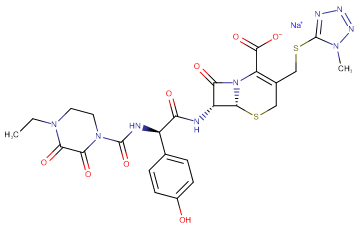
Cefoperazone sodium
CAS No. 62893-20-3
Cefoperazone sodium( Cefoneg | Cefosint | CP 52,640-2 | Perocef )
Catalog No. M15378 CAS No. 62893-20-3
Cefoperazone sodium salt is a cephalosporin antibiotic for inhibition of rMrp2-mediated [3H]E217βG uptake with IC50 of 199 μM.
Purity : >98% (HPLC)
 COA
COA
 Datasheet
Datasheet
 HNMR
HNMR
 HPLC
HPLC
 MSDS
MSDS
 Handing Instructions
Handing Instructions
| Size | Price / USD | Stock | Quantity |
| 500MG | 35 | In Stock |


|
| 1G | 48 | In Stock |


|
Biological Information
-
Product NameCefoperazone sodium
-
NoteResearch use only, not for human use.
-
Brief DescriptionCefoperazone sodium salt is a cephalosporin antibiotic for inhibition of rMrp2-mediated [3H]E217βG uptake with IC50 of 199 μM.
-
DescriptionCefoperazone sodium salt is a cephalosporin antibiotic for inhibition of rMrp2-mediated [3H]E217βG uptake with IC50 of 199 μM.
-
In Vitro——
-
In Vivo——
-
SynonymsCefoneg | Cefosint | CP 52,640-2 | Perocef
-
PathwayGPCR/G Protein
-
TargetAntibacterial
-
RecptorPBPs
-
Research AreaInfection
-
Indication——
Chemical Information
-
CAS Number62893-20-3
-
Formula Weight667.65
-
Molecular FormulaC25H26N9NaO8S2
-
Purity>98% (HPLC)
-
SolubilityWater: 50 g/L
-
SMILESCCN1CCN(C(=O)C1=O)C(=O)N[C@H](C2=CC=C(C=C2)O)C(=O)N[C@H]3[C@@H]4N(C3=O)C(=C(CS4)CSC5=NN=NN5C)C(=O)[O-].[Na+]
-
Chemical Name——
Shipping & Storage Information
-
Storage(-20℃)
-
ShippingWith Ice Pack
-
Stability≥ 2 years
Reference
1.Fass RJ, Helsel VL. Diagn Microbiol Infect Dis. 1986 Jan;4(1):77-8
molnova catalog



related products
-
L-Asparagine
L-asparagine is a non-essential amino acid that is involved in the metabolic control of cell functions in nerve and brain tissue.
-
ClpP inhibitor M21
ClpP inhibitor M21 is a noncompetitive inhibitor of ClpP with IC50 of 41.42 uM.
-
Kanosamine
Kanosamine is an antifungal agent produced by a Streptomyces sp.



 Cart
Cart
 sales@molnova.com
sales@molnova.com


